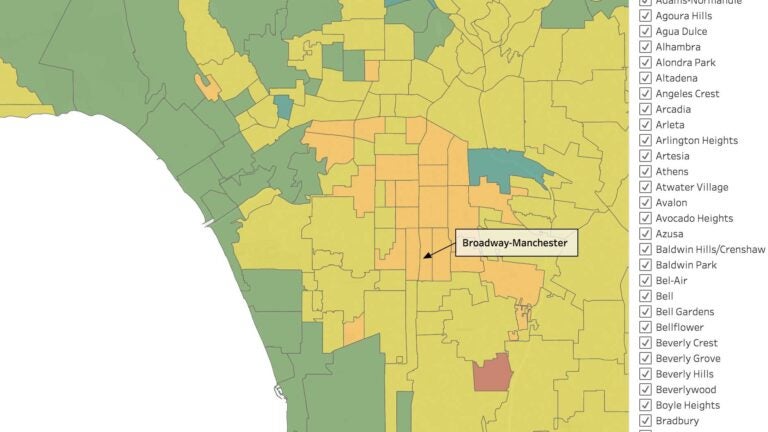
The Neighborhood Data for Social Change platform, available to the public, provides information such areas of rent fluctuations and demographic changes of Los Angeles.
(Image/Neighborhood Data for Social Platform)
Digital tool gives the public up-to-date data on their community
USC Price Center for Social Innovation launches a free platform offering research that helps uncover trends and opportunities in L.A. County neighborhoods
Would you want to know everything about your neighborhood and nearby community?
With that in mind, the USC Sol Price Center for Social Innovation has launched its Neighborhood Data for Social Change platform, a free, publicly available online resource to empower civic actors with the data they need to advocate for a better quality of life within their communities.
“Research and data really are foundational and important tools that we can use to inform how to improve the lives of people in Los Angeles and elsewhere,” said Jack H. Knott, dean of the USC Price School of Public Policy, which houses the center. “The neighborhood data platform makes a special contribution because it democratizes this research and data that otherwise might be buried away in a government agency and only available to public officials, or possibly a university and only available to academics.”
Explore a sample from the platform below
Professor Gary Painter, director of the USC Sol Price Center for Social Innovation, explained that, at a basic level, Neighborhood Data for Social Change is a platform that provides reliable aggregated data from the neighborhood level to help illuminate trends, challenges and opportunities facing Los Angeles County neighborhoods across a wide variety of policy domains. In addition, the platform goes far beyond merely presenting the data.
“The platform importantly recognizes that data are not just what you might see on a map or a table or a line graph or some other visualization, based on quantitative numbers,” Painter said. “It recognizes that data are based on the stories actually happening in these places.”
To that end, the platform focuses on storytelling with data, featuring narrative stories gleaned from the numbers, maps and charts embedded with community voice. These data-driven stories can be used to highlight issues of concern, provide analysis for why trends are moving in a particular direction and pose questions to galvanize conversations and action.
Empowering citizens, informing communities
During the launch event on Oct. 30, Luis Alvarez Leon, a postdoctoral scholar with the the USC Sol Price Center for Social Innovation, provided a tutorial and demonstration of the platform.
He showed how citizens can choose which census tracts to include in their results, seeing the data trends for each particular census tract, as well as the aggregated data trend for the neighborhoods they’re creating.
“We put a lot of effort into developing pages the public can use, regardless of data literacy, to learn about data in ways that are user friendly,” Alvarez Leon said. “We found this is often what big-data platforms lack. Just making data available is not enough to democratize data. We have to really contextualize it both within the stories of the neighborhoods and also the meaning of the data itself.”
The genesis for the platform traces back five years ago, when Melody Winter Head, the Southern California regional manager for community development at the Federal Reserve, held an event in Los Angeles on neighborhood-level data analysis. From that initial meeting, a committee was developed; and afterward, Painter, along with USC Price Center for Social Innovation Managing Director Caroline Bhalla, volunteered the center’s expertise to hold the information and conduct the analysis.
“When we started working with the L.A. Promise Zone, we recognized immediately the need for this kind of neighborhood data,” Painter said. “They couldn’t actually begin working effectively until they had it. There were all these groups we were working with that had these great ideas and innovative strategies, but they needed neighborhood data.”
Outcomes matter
Winter Head emphasized how the platform will be helpful in the Federal Reserve’s focus on stabilizing local communities.
“The reason we’re involved is because we really do want to see discussion around outcomes — not activities, not inputs, but outcomes,” Winter Head said.” Because outcomes do matter.”
She added that data can be an intervention. “It allows stories to be told and stories to be heard. It gives all of us the access to analyze data.”
Esther Wee, senior vice president of community development at Cathay Bank, which was a sponsor of the Neighborhood Data for Social Change platform, explained how it will help to better understand the needs of the community.
“We are committed to enhancing the growth and success of the communities we serve,” Wee said. “To do this effectively, we need good, reliable neighborhood-level data, so we’re very excited about this progress.”
KCETLink, the official media partner for Neighborhood Data for Social Change, will also publish data stories under City Rising, a TV and web-based program that examines the cause and effect of social issues that affect communities across California.
The Neighborhood for Social Change website will be adding variables, functionality and narrative stories as the platform evolves on an ongoing basis. Painter also noted that he hopes the platform leads to partnerships between the Price Center for Social Innovation and change-makers.
“This neighborhood data platform is not an end,” Painter said. “It’s a tool, a way to facilitate and understand change. Really, it’s just the beginning.”
